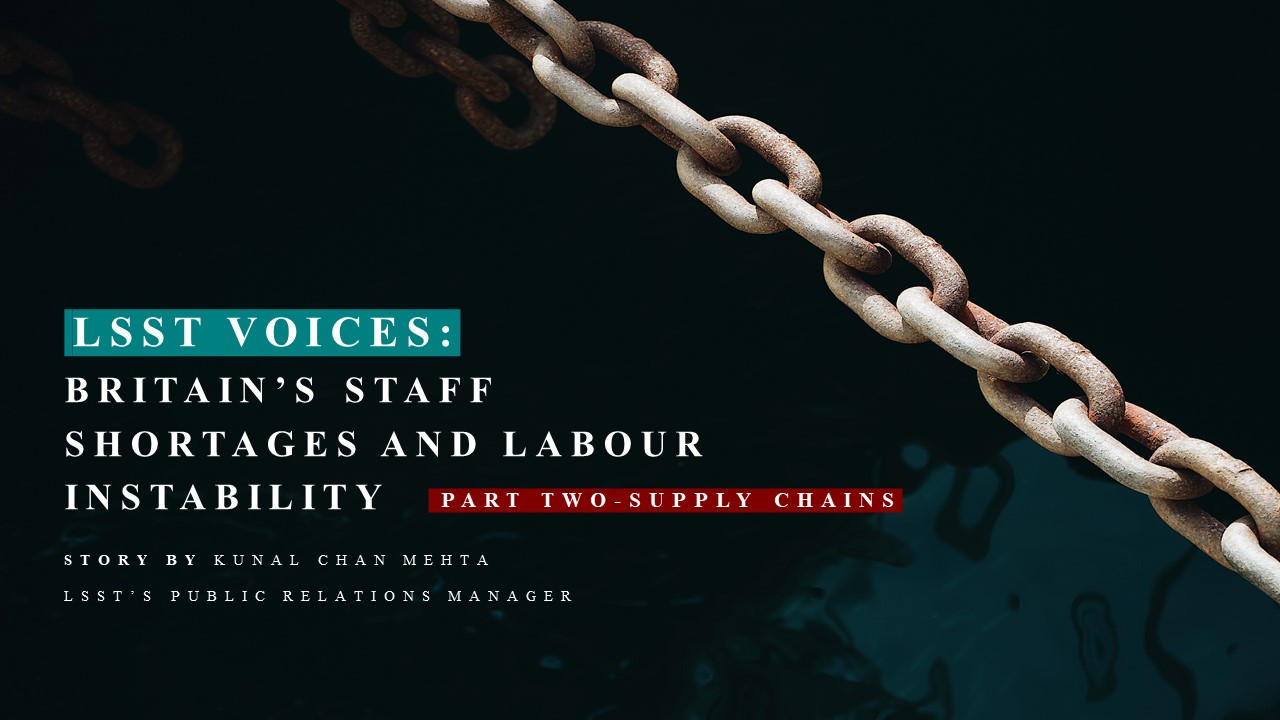LSST voices: Britain’s staff shortages and labour instability – Part Two
By Kunal Chan Mehta | Article Date: 11 November 2021

Since the COVID-19 pandemic began, global supply chains are having a tough time. Hiccups in the traditional supply chain – often called the bullwhip effect – are not new, but the concern is around how supply chains and the sets of organisations around them have been habitually focused on achieving financial efficiency above all else. Here, in part two, we gather expert LSST voices on supply chain bottlenecks, shortages, and backlogs.
‘Owing to frantic competitiveness and excessive profit intensification, few organisations are immune to supply chain problems today,’ warns Renata Oliveira Carvalho, LSST’s former SU President and current Business Lecturer. ‘With rising raw material costs, wages, and supply chain blockages – notwithstanding a shortage of HGV drivers post-Brexit – there will be consequential cost increases in energy, logistics and commodities.’
Renata reminds us that supply chains are pipes connecting supply to demand and should focus more on quality outcomes – rather than unscrupulous financial incomes. Further, the way we think about the supply chain future is going to end up shaping it. This pandemic is unique because it has simultaneously impacted both supply and demand. In turn, there remains a genuine crisis – a pandemic paralysis: On one hand, the crisis is exasperated by an explosion of pent-up product demand as lockdowns steadily ease; and, on the other, people are still buying more stuff than they need adding immense pressures to an already fractured system.
LSST participants in this series predicted that the shortages, blockages and discrepancies between supply and demand will endure well into 2023, and possibly beyond.
Bill Piper, a LSST Business student and the Managing Director of Evington Executive Cars – an executive taxi business, recalls the anxiety and the empty supermarket shelves during 2020: ‘I believe there are never really shortages – there are panics. For instance, during the recent fuel crisis, people were filling up their vehicles and any other container to get as much as they possibly could.’
For some significant period, global as well as local economic growth is likely to be constrained by supply. For example, Krisztina Karai, a Health and Social Science LSST student, said: ‘My handmade soap, balm and beard oil business, KARAISOAP, lost most of its customers during the successive lockdowns – and now, just as the business was recovering, my trade is impacted by supply chain hurdles and bolstered prices for the components I use.’
Political and trade tensions
Pandemic paralysis along with political tensions can only lead to disorder and even confusion for manufacturers and distributors who no longer can make or supply as they once did.
Mr Mohsin Riaz, Dean of LSST Birmingham, observed: ‘Nobody wants empty shelves. Hence, we must question why supply chains are not yet a 24/7 system. For me, that is the physical problem. By contrast, there is also a psychological, moral, problem where we become overjoyed when something is extremely cheap but do not ask why. The answer is that someone – somewhere, overseas all too often – has been exploited. If this supply chain crisis does only one thing, it should be to focus on treating its workers more fairly’
‘The first rule of supply chain management is to plan all the resources that go towards meeting customer demand rather than looking avariciously at margin maximisation,’ said Mr Syed Rizvi, LSST’s Dean of Learning and Teaching. ‘As we gradually leave behind the worst of the pandemic, global supply chain management will be heavily reviewed – and thus improved – establishing a more sturdy and strong global supply chain model that will involve more AI and forecasting data so decisions can be made more quickly.’
Offsetting impact
There is relatively little slack built into global supply chains so businesses, working to offset the impact of the supply chain crisis through cost savings, will only be able to do so by implementing price increases. Shan Wikoon, a Business Lecturer at LSST’s Elephant and Castle campus, said: ‘During this crisis, the best way to save these costs would be to focus on AI, robotics, driverless vehicles and 3D printing – but frustratingly the technology is too expensive or not yet fully developed to tackle supply chains concerns head on.’
Although a link between staff shortages and supply chains exists, the crisis was a blessing for many of Shan’s students who work part-time. ‘Some even told me that their income had doubled over the last six months’, Shan noted.
Mr Mohammed Zaidi, LSST’s Deputy CEO, taking a broader view, added: ‘Most global supply chains are complex and fragile. In fact, most modern supply chains are not designed to cope with large uncertainties around supply or demand – let alone delays. There is a clear call for technological improvements, and I feel this crisis will stimulate the Higher Education sector to focus on finding meaningful solutions to this.’
‘At LSST we are convinced by the argument that an educated society is crucial for economic growth. Now more than ever, in the fields of supply chain management, we need people to continue to learn, debate and research to constantly stay innovative,’ added Ron Cohen, one of LSST’s Governors.
Irina Barariu, LSST’s Student Union President, stated: ‘It is a classic supply chain mismatch. Everyone should have known that after a lockdown comes lockdown-easing. Demand was never going to be gradual. It was pent-up as people spent a prolonged 18 months sequestered away. For me, the mismatch is not so much about a supply chain crisis but more of a strategic planning one.’
Harpreet Kaur, a LSST Course Coordinator and Senior Lecturer in Business, discussing contemporary supply chain strategies and digital asset management, said: ‘Blockchain has proven to be effective in driving value in the supply chain. Recent developments have particularly focused on the larger companies as well as start-ups. Although quickly evolving, these blockchains are enabling organisations to be more innovative which allows them to fulfil a range of wider needs.’
Adapt and change
While observing the student and staff comments, Mr Ali Jafar Zaidi, LSST’s Marketing and Admissions Director, said: ‘The pandemic has thrown a huge spanner at global supply chains and caused chaos without bias to large or small organisations. This has left incredibly damaging results in its wake. But as we wait for the supply chains to return to strength, which they will, we have an abundance to learn about how our supply chains performed during the pandemic.’
When asked what could help solve the crisis, Mr Ali Jafar Zaidi surmised: ‘Ideally the government needs to re-shore manufacturing and strengthen our domestic supply chains – so that organisations make longer-term investments in the UK workforce.’
In this highly complex world of ours, a supply chain management framework for making sense of its affairs is elusive. Thus, we need improved global models for forecasting how supply chains will evolve and react to crises – and for how unfair and prejudicial profiteering is monitored by central governments. Through AI and real-time sharing, technology can improve communication and collaboration, and this will foster better supply chain traceability and transparency for everyone.
To be continued in LSST voices: Britain’s staff shortages and labour instability: Part 3 – The Everything Shortage. LSST’s Press Office invites students and staff to contribute to this ongoing and progressive series by emailing the author kunal.mehta@lsst.ac





Thanks to the students union for the continued support and interest to listen to the student’s opinion.
It’s so easy to blame Brexit for things. – But as Students, we are required to do ‘critical research’. So look at the other factors.
Look at the driver shortages in other countries as well as Britain – like Germany, Ireland USA.
Then consider the common factor/s.
Covid.
I was impressed by the astute observations provided by both students and staff of LSST and the supply chain crisis and fully concur that the causes of this scenario are multifaceted.
In addition to the above causes, other key factors that significantly impact supply chain internationally are as follows:
1. The lack of availability of resources of has traditionally been taken for granted, that impact growing economies e.g. lithium and rare earths required for electric batteries for a variety of products (e.g. hundred or newly built trucks in the U.S.A. are just sitting idle due to the lack of lithium- based computer chips). As society expands into a more digital arena, a management and technological shift is needed to address such shortages e.g. identifying and using substitutes for lithium (see https://www.power-technology.com/features/lithium-battery-alternatives/), gallium, titanium, and other rare earth elements as well as the recycling of such materials through in energy efficient manufacturing systems. Indeed, the issue of not having computer chips being readily available has a major knock – on effect on a modern society. More companies like Altenergy.com can play a role in helping to address this issue.
2. Regulation derived H.R. policies and rules that result in low level productivity and engagement in the supply chain such the enforcement of vaccinations on
on logistics workers that refuse to comply (for various reasons).
3. Policies linked to easy access to “free” money for not working and de- incentivizing social and political environment for entrepreneurship (universal basic income) undermines the work ethic in many cases. As a result of such a policies in the USA, companies are struggling to get employees and there is now over 8 million job vacancies in the U.S.A.. For instance, many restaurants, in California and New York have now closed due to staff shortages. Likewise, this also has impacts logistics companies and , as a result, the overall supply chain.
4. The lack of thorough neutral/unbiased career assessments of workers and directing them into careers that are suitable for them. Often, potential workers have little self – awareness of their skills, abilities, talents, and knowledge that, when identified, unlocked, with positive support mechanisms, can be
be mapped and directed to appropriate vocations dictated by labour market demands. This concept has been proven by empirical data, marketing professionals, H.R. professionals, and economists.
If governmental funding for such facilities was in place more, with follow-up elements embedded such a strategy was effectively implemented, potential workers would not be at the mercy of the marketing of training providers and employers and end up (with in many cases after investing considerable time and money) in being locked into training programmes and work environments that are unsuitable for them. Indeed, training for its own sake or trying to enter the workforce alone (without effective preparation) that does not match with individual and market requirements result in “lose-lose” scenarios. This has been proven repeatedly where large amounts of time, money, and energy is spent (private and /or governmental) with minimal or no real benefit to society or career enrichment. For instance, if there is growing market demand for logistics workers, if potential workers are, after undergoing robust career assessments, are identified as being suitable in such vocations and are trained and mapped to such a career, and supported accordingly, such “gaps” in this industry can be partially addressed.